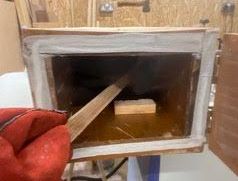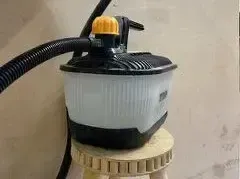Get In Touch Today - 07946 221169
What Is Steam Bending?
Creating a customised wooden accessory, cabinet or furniture piece often requires bends and curves. There are several ways to do this, but steam bending is one of my go-to methods.
Using steam bending, I can mould a straight piece of wood into a smooth twist. This helps create bespoke items that are both practical and stunning pieces of art. This page explains why I use steam bending, how I approach a steam bending project, and what the process involves.
Let's get into it.

What Is Steam Bending?
I use several pieces of equipment in my workshop for steam bending. The most distinct are the steam box and forms for bending and drying.
In short, steam bending uses moisture (steam) to relax a piece of wood into its new, curved position.
When someone twists and bends a straight plank, the fibres on the inside of the curve are compressed. At the same time, the fibres on the outside stretch out.
This leads to a natural situation called ''springback''. The compressed and stretched fibres hold a lot of tension and try to push back to the original ''straight'' position.
Steam bending introduces moisture to the fibres and cells throughout the wood. It's particularly effective at releasing the compression on the inside of the curve, relaxing the lignin (the polymers in the cell walls - basically, the glue that holds wood together and in its shape), and effectively resetting them. With the tension eliminated, they sit stress-free and maintain the curved shape.
What Is Steam Bending?
I use several pieces of equipment in my workshop for steam bending. The most distinct are the steam box and forms for bending and drying.
In short, steam bending uses moisture (steam) to relax a piece of wood into its new, curved position.
When someone twists and bends a straight plank, the fibres on the inside of the curve are compressed. At the same time, the fibres on the outside stretch out.
This leads to a natural situation called ''springback''. The compressed and stretched fibres hold a lot of tension and try to push back to the original ''straight'' position.
Steam bending introduces moisture to the fibres and cells throughout the wood. It's particularly effective at releasing the compression on the inside of the curve, relaxing the lignin (the polymers in the cell walls - basically, the glue that holds wood together and in its shape), and effectively resetting them. With the tension eliminated, they sit stress-free and maintain the curved shape.
What Components Are Involved In Steam Bending?
Steam bending involves several tools and pieces of equipment you'll need to buy or make. These include the following:
- Steam box – As the most critical component, the steam box is an sealed container into which you place the straight wood (before bending). There must also be somewhere to pump in steam from a boiler and a couple of small holes in the top. These allow excess steam to escape. While you can buy dedicated versions of these, you could also make one using PVC and plywood.
- Boiler – The boiler is anything you can use to boil water, creating steam to be channelled into the steam box. Something as simple as a steam wallpaper stripper will do this perfectly!
- Thermometer – It’s also best practice to have a thermometer of some kind. The more accurate your variables are, the more consistent your resulting curves will be!
- Drip pan – To catch any drips from the steam box.
- Bending form – Create a form to bend the wood around once it's removed from the steam box.
- Clamps – Use clamps to hold the wood firmly against the bending form.
- PPE – Thick leather gloves are a must. I also wear long sleeves and a leather apron, taking extra care when removing the wood from the steam box.
Why do I use steam bending to make custom wooden pieces?
Steam bending is one of my go-to methods. Here are the main reasons I use it whenever necessary:
- Steam bending changes the shape of the wood grains instead of breaking or cutting them. The result is a solid, stiff curve.
- By relaxing the tension in the lignin (cell walls), steam bending means the wood retains its new shape indefinitely.
- Steam bending means I waste very little wood compared to other techniques.
- It's an eco-friendly technique, requiring no toxic chemicals or glue and very little energy consumption (just the boiler to create the steam).
- Using a compression strap, it's possible to make very tight bends. It's incredible to see how much some woods can bend without getting damaged!
- And finally, because it looks so good! Steam bent features are just captivating. When done properly they take pieces to a whole new level.

How I steam bend your tailored wooden items!
Note: Only attempt steam bending with proper training and professional assistance! The most significant risk is burns or scalds from the steam box or boiler.
Steam bending is only appropriate for certain kiln-dried hardwoods with non-interlocking fibres. In general, these include oak, ash, walnut and elm. Maple and cherry are also great options. I always choose wood free from knots or any other defects. These weak points are more likely to snap or give way during the bending process or can affect how smooth the curve is when complete.
With the design in place and the wood chosen, I then cut the wood to the required length and thickness. The wood goes into the steam box once the boiler is up to temperature (just under 100 degrees C). It generally stays in for about one hour for every inch thick. It is possible to steam wood for too long!
After enough time has passed, I carefully remove the wood using my leather gloves (avoiding getting scalded!) and clamp it to the bending form. While doing this quickly is essential, there's no need to rush. I get about ten minutes of flexibility for every inch of thickness in the wood.
When working with thicker pieces, I’ll prep the form while the wood is in the steam box. There’s usually plenty of time. But some thinner pieces sometimes only sit in the steam box for 15 to 20 minutes. In these cases, I'll make sure all the forms are set up and ready before I put the wood in. The last thing I want is for the wood to be taken out and ready and the form not be set up properly! You’ve only got a certain amount of time to work with it once it’s out! I usually use compression straps and other items to ensure a structurally sound bend.
Now it's time for drying! In my workshop, this usually takes around two days. If you want to be super-sure the wood is ready to come out the form, use a moisture meter. The moisture level in the wood should be below 10%.
I'll then remove the form, and there we have it!
Create your own bespoke carpentry!
Feathers & Fern is a local woodworking and cabinetry business based in Measham, Leicestershire. We service all the surrounding areas, including Burton-on-Trent, Derby, Leicester, Coventry, Lichfield and Tamworth.
If you've been dreaming of a new, unique table or chair or a decorative piece of art, I would love to hear from you. Depending on your design ideas and the existing space, steam bending is a technique I may use to make the perfect product for you! After you get in touch, I'll explain what I can do for you and listen to your design ideas. Together, we'll develop rough sketches and make a few basic decisions on wood types, finishes, colours, etc.
With a 50% deposit, I order the materials and get to work! Your dream piece of furniture or artwork is just around the corner!
Reach out for an obligation-free, friendly chat on 07946 221169 Alternatively, email me at jotham@feathersandfern.com or fill out the form on my contact page.
I look forward to hearing from you!
Get In Touch
If you've been dreaming of a new, unique table or chair or a decorative piece of art, I would love to hear from you.
Contact Us
Let's work together!
Feathers & Fern
123 Atherstone Rd, Measham, Swadlincote DE12 7EJ

Feathers & Fern
123 Atherstone Rd, Measham, Swadlincote DE12 7EJ
Tel: 07946 221169
Email: jotham@feathersandfern.com

